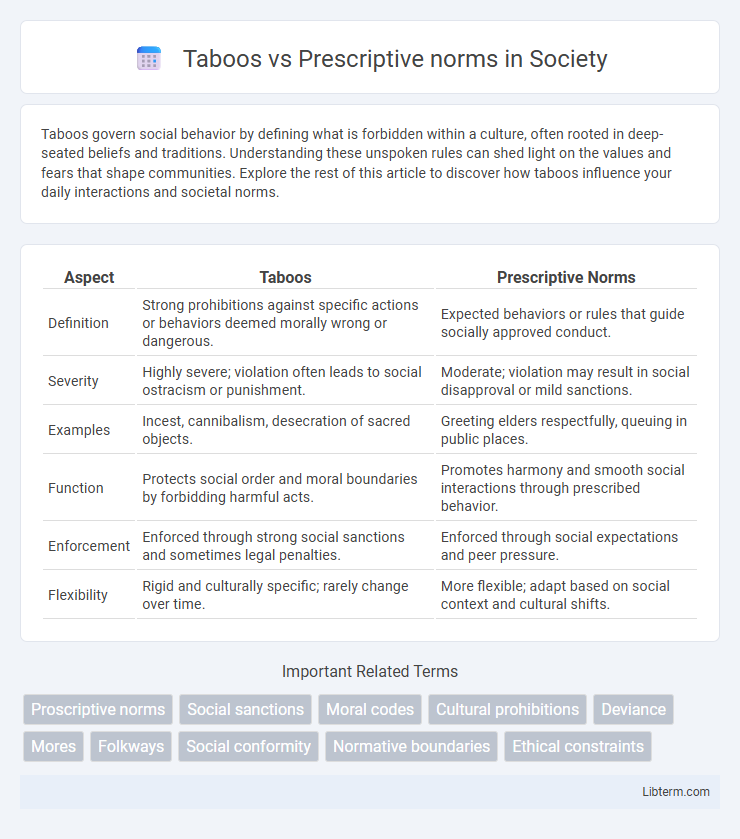Taboos govern social behavior by defining what is forbidden within a culture, often rooted in deep-seated beliefs and traditions. Understanding these unspoken rules can shed light on the values and fears that shape communities. Explore the rest of this article to discover how taboos influence your daily interactions and societal norms.
Table of Comparison
| Aspect | Taboos | Prescriptive Norms |
|---|---|---|
| Definition | Strong prohibitions against specific actions or behaviors deemed morally wrong or dangerous. | Expected behaviors or rules that guide socially approved conduct. |
| Severity | Highly severe; violation often leads to social ostracism or punishment. | Moderate; violation may result in social disapproval or mild sanctions. |
| Examples | Incest, cannibalism, desecration of sacred objects. | Greeting elders respectfully, queuing in public places. |
| Function | Protects social order and moral boundaries by forbidding harmful acts. | Promotes harmony and smooth social interactions through prescribed behavior. |
| Enforcement | Enforced through strong social sanctions and sometimes legal penalties. | Enforced through social expectations and peer pressure. |
| Flexibility | Rigid and culturally specific; rarely change over time. | More flexible; adapt based on social context and cultural shifts. |
Understanding Taboos: Definition and Origins
Taboos are deeply ingrained prohibitions rooted in cultural, religious, or social beliefs that forbid specific behaviors, often eliciting strong emotional reactions like disgust or fear. Unlike prescriptive norms, which guide acceptable behavior through recommendations or rules, taboos are absolute prohibitions considered crucial for maintaining social order and identity. Their origins trace back to ancient traditions and collective unconscious influences, reflecting a society's core values and collective fears.
What Are Prescriptive Norms?
Prescriptive norms are social rules that dictate acceptable behaviors explicitly encouraged or required within a group or society, guiding individuals on how they should act in specific situations. These norms often manifest through laws, regulations, or formal directives, and their violation typically results in social sanctions or penalties. Unlike taboos, which prohibit actions deemed morally or culturally unacceptable, prescriptive norms actively promote positive or necessary behaviors to maintain social order and cohesion.
Key Differences Between Taboos and Prescriptive Norms
Taboos are strong social prohibitions that forbid specific actions due to moral or cultural beliefs, whereas prescriptive norms guide acceptable behavior through positive recommendations or rules. Taboos invoke significant social sanctions and emotional reactions when violated, often linked to deep-rooted cultural or religious values, while prescriptive norms typically encourage behavior without severe punishment. Understanding these distinctions is crucial for analyzing social control mechanisms within different societies.
Cultural Significance of Taboos
Taboos carry deep cultural significance, serving as powerful social prohibitions that shape community identity and maintain social order by delineating sacred or forbidden actions. Unlike prescriptive norms, which guide acceptable behavior through explicit rules, taboos evoke strong emotional responses and often relate to fundamental values such as purity, morality, and religious beliefs. Their enforcement preserves cultural heritage and reinforces collective moral boundaries, highlighting practices that are culturally inviolable and essential to group cohesion.
How Prescriptive Norms Shape Social Behavior
Prescriptive norms shape social behavior by providing explicit guidelines and expectations for acceptable conduct within a community, reinforcing positive actions that align with cultural values. These norms influence individual decision-making through social approval and sanctions, encouraging conformity and cooperation. Understanding prescriptive norms is essential for comprehending how societies maintain order and promote prosocial behavior across diverse contexts.
Examples of Taboos Around the World
Cultural taboos such as the prohibition of eating beef in Hindu communities and the avoidance of pork in Muslim and Jewish dietary laws highlight deeply ingrained societal restrictions. In Japan, taboos include discussing personal income or family issues in public, emphasizing social harmony. These examples contrast with prescriptive norms like traffic rules, which guide behavior without invoking strong moral prohibitions.
Common Prescriptive Norms in Modern Societies
Common prescriptive norms in modern societies include laws against theft, regulations promoting public health such as vaccination mandates, and workplace codes of conduct that ensure professionalism and fairness. These norms function to guide acceptable behavior by setting clear societal expectations and often carry formal penalties for violations. Unlike taboos, which are culturally ingrained prohibitions often linked to moral disgust, prescriptive norms are more flexible and subject to change through legal or social reform.
The Role of Enforcement: Taboos vs Prescriptive Norms
Taboos are enforced through strong social sanctions, often involving moral outrage and ostracism, which create an implicit but powerful deterrent against violations. Prescriptive norms rely on explicit rules and formal enforcement mechanisms, such as laws or organizational policies, to maintain compliance and order. The differential enforcement intensity highlights how taboos function through internalized social pressures, while prescriptive norms depend on external authority and structured regulation.
Breaking Taboos vs Violating Prescriptive Norms: Social Consequences
Breaking taboos often triggers intense social condemnation, as taboos are deeply rooted prohibitions linked to core cultural values and identity. Violating prescriptive norms typically results in milder social disapproval or corrective measures, since these norms guide expected behaviors without invoking severe moral outrage. The social consequences of breaking taboos include ostracism and stigma, while violating prescriptive norms may lead to criticism or social sanctions aimed at behavioral correction.
Evolving Taboos and Changing Norms in Society
Evolving taboos reflect deep-rooted cultural prohibitions that shift over time as societies reassess moral boundaries, such as attitudes toward topics like mental health and sexuality. Changing prescriptive norms, meanwhile, represent explicit societal rules and expectations that adapt with legislative reforms and social movements, impacting behaviors in public and private spheres. The dynamic interaction between evolving taboos and changing norms drives progressive transformations in social acceptance and legal frameworks.
Taboos Infographic

 libterm.com
libterm.com